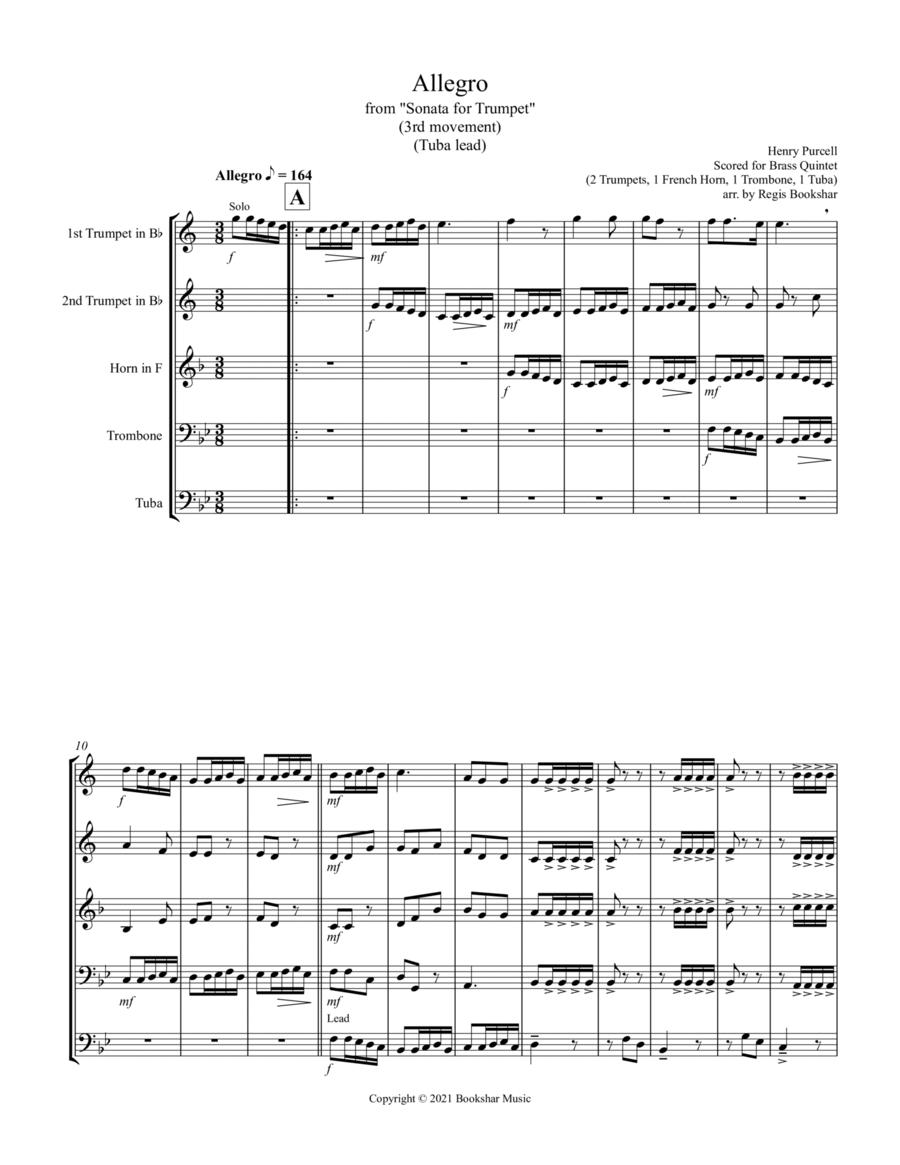Brass Ensemble Horn,Trombone,Trumpet,Tuba - Level 4 - Digital Download SKU: A0.813574 Composed by Henry Purcell. Arranged by Regis Bookshar. Baroque,Instructional,Multicultural,Standards,World. Score and parts. 8 pages. Regis Bookshar #6429769. Published by Regis Bookshar (A0.813574). Brass Quintet - Advanced/Intermediate - Digital Download. This arrangement of the Allegro movement from Henry Purcell's Sonata for Trumpet would be a fabulous addition to any music library and could be performed for concerts, recitals and church services. It is suitable for high school and college students but professional musicians would also enjoy playing this selection. This selection is one of the arrangements from The Regis Bookshar Trumpet Ensemble's extensive music library, many of which are being made available for the first time. They have performed the Trumpet Quintet version of this composition quite often for numerous weddings and other special occasions. The original composition was written in D Major but Regis Bookshar has transposed it to Bb Major, making it a little easier for many modern musicians. Included are a score and a complete set of parts (8 pages). The 17th century composer, Henry Purcell, is generally considered to be one of the greatest English composers of his generation. His Sonata for Trumpet and Strings in D Major, composed in 1694, was probably written for the London Theatre, where a fine tradition of trumpet playing had developed. Purcell almost certainly had in mind either John Shore or his brother, William, the most renowned trumpet players in England at the time. The trumpets of the time were normally tuned in D and there were no valves on the Baroque trumpets, so they were limited in the number of notes that they could play. The term Sonata here probably means no more than a piece of incidental music and looks forward to the style that would become the solo concerto where soloist and strings are pitted against each other but also looks back to an older type of instrumental music which emphasized equality between members of the ensemble. The music is in three movements and looks forward to the fast-slow-fast plan popularized by Vivaldi's concertos. Regis Bookshar thought that it would be wonderful if other instrumentalists, besides trumpet players, could also have the opportunity to play the Allegro movement from Purcell's Sonata for Trumpet, so he has created other arrangements of this selection. This particular arrangement is for a Brass Quintet, consisting of 2 Trumpets, 1 French Horn, 1 Trombone and 1 Tuba, and features the Tuba on the melody, but there are Quintets, Sextets, Septets and Octets readily available for a wide variety of instrumental ensembles. Please take the time to look for other versions of this piece. You may find something else that may suit your needs. I would also encourage you to search for other arrangements by Regis Bookshar as well, as there are numerous arrangements in a wide variety of styles also available for purchase. You may find something else which might interest you. Please continue to check back periodically because new arrangements are added as often as possible. I'm certain that this exciting arrangement of Purcell's Allegro from his Sonata for Trumpet will continue to entertain both performers and audiences alike for years to come.
